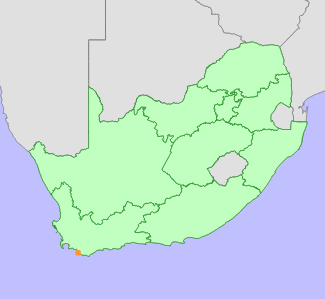|
Scientific Name | Pterygodium vermiferum E.G.H.Oliv. & Liltved |
Higher Classification | Monocotyledons |
Family | ORCHIDACEAE |
National Status |
Status and Criteria | Vulnerable D2 |
Assessment Date | 2012/02/07 |
Assessor(s) | L. von Staden |
Justification | A highly localized (EOO 12 km²) species currently known from four locations and potentially threatened by coastal development, alien invasive plants and road construction. |
Distribution |
Endemism | South African endemic |
Provincial distribution | Western Cape |
Range | Die Kelders to Stanford. |
Habitat and Ecology |
Major system | Terrestrial |
Major habitats | Overberg Dune Strandveld, Agulhas Limestone Fynbos |
Description | Well drained sandy soil on coastal limestone. |
Threats |
| One subpopulation is protected within a private nature reserve and is not threatened. The other three subpopulations were all recorded along the road between Die Kelders and Stanford. They are not currently threatened, but could potentially be affected by road construction, coastal development and alien invasive plants, which have infested much of the coastal limestone fynbos in the area. |
Population |
Four subpopulations are known, within a very small area. Plants do not require fire to flower, but flowering is stimulated by fire. The subpopulation at the type locality consists of about 80 plants (counted after a fire), while a second subpopulation consists of about 17 plants. Subpopulation sizes for the other two subpopulations are not known.
|
Population trend | Stable |
Conservation |
| Protected in Grootbos Private Nature Reserve. |
Assessment History |
Taxon assessed |
Status and Criteria |
Citation/Red List version | | Pterygodium vermiferum E.G.H.Oliv. & Liltved | VU D2 | 2012.1 | |
Bibliography |
Oliver, E.G.H., Liltved, W.R. and Pauw, A. 2008. Pterygodium vermiferum (Coryciinae), a new, autonomously self-pollinating, oil-secreting orchid from the Western Cape of South Africa. South African Journal of Botany 74(4):617-622.
|
Citation |
| von Staden, L. 2012. Pterygodium vermiferum E.G.H.Oliv. & Liltved. National Assessment: Red List of South African Plants version 2024.1. Accessed on 2025/11/17 |
 Comment on this assessment
Comment on this assessment


